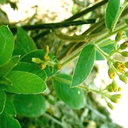In vivo and in vitro anti-inflammatory effects of ethanol fraction from Periploca forrestii Schltr.
Açar sözlər
Mücərrəd
OBJECTIVE
To determine the anti-inflflammatory effects of an ethanol fraction of Periploca forrestii Schltr. (EFPF) and to investigate the potential mechanisms underlying in vivo and in vitro models.
METHODS
The antiinflflammatory effects of EFPF were evaluated using the xylene-induced mouse ear edema and carrageenan-induced rat paw edema models in vivo. In vitro, RAW264.7 cells were exposed to 0-800 μg/mL EFPF and the cell viability was determined by 3-(4,5-dimethylthiazol-2-yl)-2,5-diphenyltetrazolium bromide (MTT) assay. Then cells were treated with different concentrations of EFPF (100-400 μg/mL) and stimulated with lipopolysaccharide (LPS, 1 μg/mL) for 24 h. The supernatant was analyzed for nitric oxide (NO) using the Griess reagent, and the levels of inflflammatory mediators and cytokines were determined using enzyme-linked immunosorbent assays for prostaglandin E2 (PGE2), tumor necrosis factor α (TNF-α), interleukin (IL) 6, and IL-10. The protein expressions of inducible NO synthase (iNOS), cyclooxygenase-2 (COX-2), nuclear factor κB (NF-κB), and mitogen-activated protein kinases (MAPKs) including extracellular signal-regulated kinase (ERK), c-Jun N-terminal kinase (JNK), and p38 MAPK were examined by Western blot.
RESULTS
Compared with the control group, EFPF signifificantly reduced mouse ear edema and rat paw edema rate (P<0.05 or P<0.01). Compared with the LPS group, EFPF signifificantly inhibited the LPS-stimulated production of NO, PGE2, TNF-α and IL-6 (P<0.05 or P<0.01), and increased the IL-10 production (P<0.05). EFPF also signifificantly inhibited LPS-induced protein expressions of iNOS and COX-2, suppressed the phosphorylation and degradation of inhibitor of NF-κB-α, decreased p65 level, and inhibited the phosphorylation of p38, ERK1/2 and JNK P<0.05 or P<0.01).
CONCLUSIONS
EFPF exerted anti-inflflammatory effect by reducing protein expressions of iNOS and COX-2 and the production of the inflflammation factors, including TNF-α, IL-6, NO and PGE2, mainly through inhibition of LPS-mediated stimulation of NF-κB and MAPK signaling pathways.




